Are you looking for a dual-purpose chicken that leans toward meat production?
The New Hampshire Red breed can be your perfect choice. This breed has a quick maturity and feather growth rate, goes broody, and makes a wonderful mother.
It is less famous than the Rhode Island Red despite having a similar appearance.
The New Hampshire Red is identical in size to the Rhode Island Red, but its body shape is more triangular.
This dual-purpose bird has much to offer you as a modern homesteader. Please keep reading to learn all you need to know about the New Hampshire Red chicken breed.
From its history and origin, variants, temperament, and more. Let’s get right to it!

Table of Contents
History and Origin
As you probably inferred from the name, the New Hampshire Red breed originated in the U.S. state of New Hampshire.
This breed resulted from crossbreeding the Rhode Island Red stock in the early 20th century. The objective was to develop a cold hardy breed with high-quality meat and egg production.
Breed Standard
The American Poultry Association (APA) and the American Bantam Association (ABA) set the breed standard for the New Hampshire Red chicken.
These standards outline the ideal physical attributes of the breed, such as height, weight, feather color, etc.
According to the APA Standard of Perfection, the characteristics of the New Hampshire Red are:
- A single comb
- A large head
- A plump body with well-rounded curves
- The feathers and tail should have some black patterns and be a consistent shade of red
- The ideal weight for males is between 7 and 8 lbs (3-3.5 kg)
- The perfect weight for hens is between 5 and 6 lbs (2.2-2.7 kg)
Is This an APA-Recognized Breed
The American Poultry Association (APA) acknowledges the New Hampshire Red chicken breed. The breed received the APA’s recognition in 1935.
Since then, the New Hampshire Red has gained popularity as a backyard and industrial chicken.
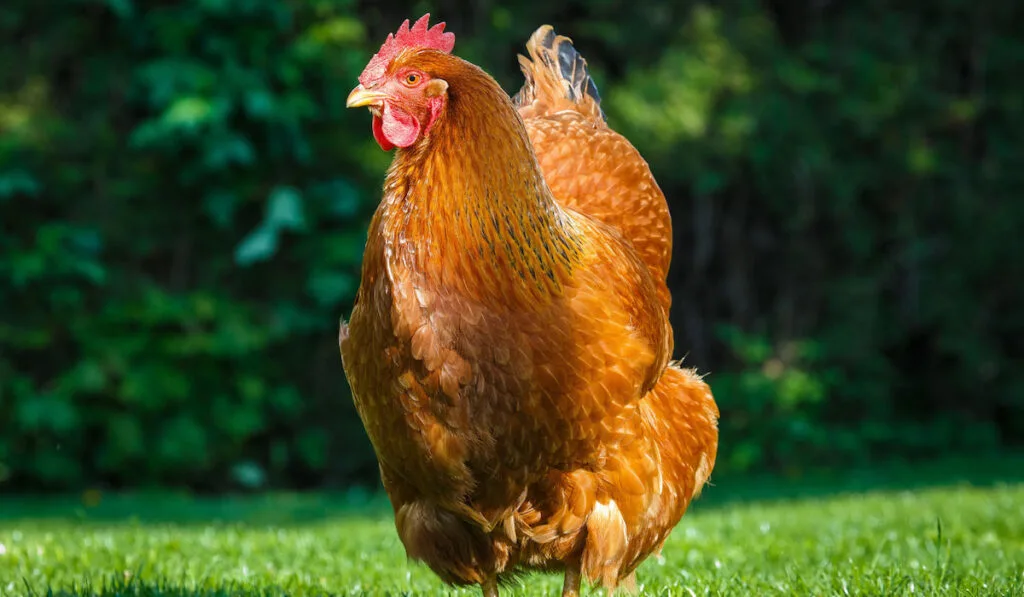
Appearance
New Hampshire Red chickens have gorgeous golden red-brown or chestnut red feathers.
They have black spots on the tips of their neck and tail feathers.
The breed has a single average-sized comb that may slightly flop over in hens.
Size/Height/Weight
The New Hampshire Red has a deep and broad body. It is a medium-sized breed of chicken.
A mature rooster is 30 in. (76 cm) tall and weighs between 7 and 9 lbs (3.2-4 kg). An adult hen is approximately 25 in. (64 cm) tall and weighs between 5 and 7 lbs (2.3-3.2 kg).
Standard weights:
- Cock: 8.5 lbs (3.9 kg)
- Hen: 6.5 lbs (2.9 kg)
- Cockerel: 7.5 lbs (3.4 kg)
- Pullet: 5.5 lbs (2.5 kg)
Color
The color ranges from medium to light red, dwindling in the sun. It has an eye-catching, vivid red feather pattern. Compared to hens, roosters have redder feathers.
Roosters and hens have yellow or orange beaks, legs, and feet.
Rare Colors
The New Hampshire Red breed is red, with some variances in color intensity ranging from light to dark red. There are no exceptional or rare feather colorations in the breed.
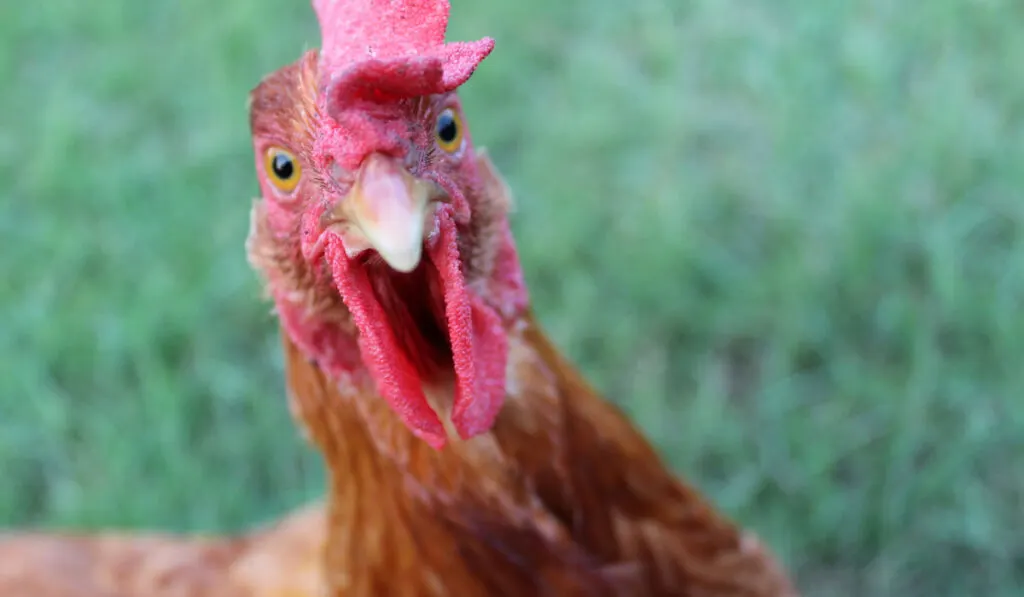
Temperament
The New Hampshire Red chicken is friendly and docile. You can easily tame this pleasant bird, making it a wonderful pet.
These birds have a calm demeanor and are often easy to handle.
Also, they get along nicely with other hens and are friendly to people.
This breed is curious and aggressive, especially when competing for food. And they are willing to push other flock members aside.
These birds are content to forage in your yard for goodies and aren’t particularly noisy.
Brooding
The New Hampshire Red hens are good setters and tend to go broody. They make excellent mothers if you allow them to hatch their own chicks.
Broodies can take in extra chicks, but this varies from hen to hen.
Egg-Laying
The New Hampshire Red is one of the best egg-laying chicken breeds.
It can produce about 200-220 eggs annually, approximately three eggs each week.
This breed is an excellent choice if you want to keep chickens for eggs. They provide a steady supply of eggs throughout the year.
The breed lays large tinted/light brown eggs.

Meat Production
Most farmers don’t usually breed New Hampshire Red chickens for meat production.
They are smaller than other breeds that produce meat.
However, you can choose to raise them for meat. Their robust body and rapid growth make them appropriate for meat production.
Other Uses
Some people keep the New Hampshire Red chicken for educational purposes and 4-H projects. Moreover, you can also raise them as pets or as a hobby.
Cold and Heat Tolerance
New Hampshire Red chickens are cold-tolerant. The breed is famous for its toughness and excellent adaptations.
They are hardy birds that can thrive in diverse climates.
Although they can handle the heat, they still require shade.
The New Hampshire Red can suffer heat stress in sweltering and humid conditions.
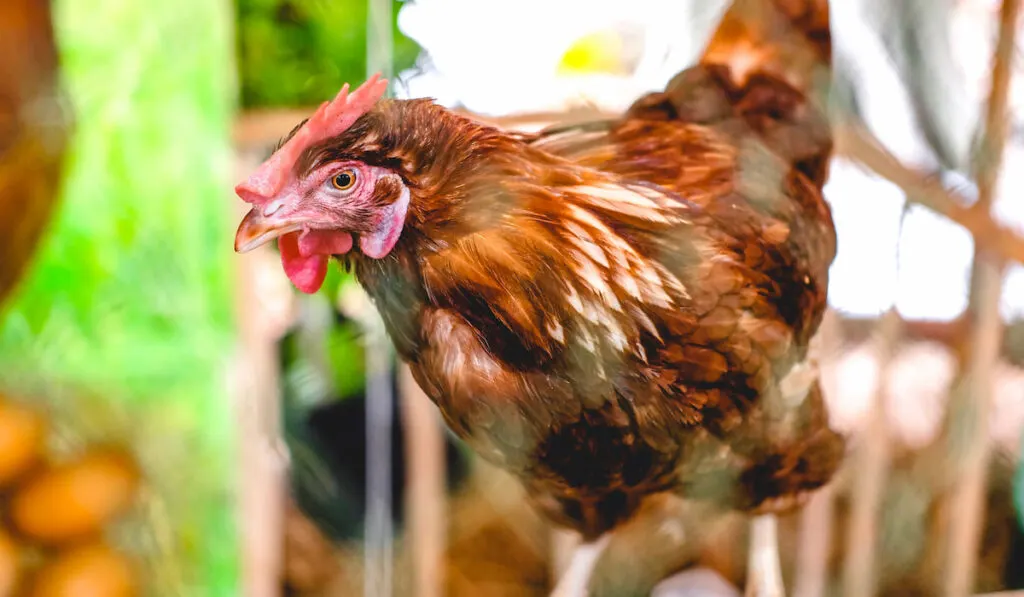
Sexing (How to Identify Male From Female)
It can be challenging to distinguish between young male and female New Hampshire Red chickens. However, there are several traits to watch out for in general.
Here are some techniques you can employ:
Vent Sexing
This technique includes checking a young bird’s vent, commonly known as the cloaca, to ascertain its sex. The vent of a male is round-shaped, whereas the vent of a female will resemble an inverted “V”.
You should seek assistance from a skilled specialist when using this technique.
Plumage
The male New Hampshire Red will grow longer and more pointed hackle feathers as it grows older.
The female will have feathers that are shorter and more rounded.
Behavior
Roosters are more territorial and aggressive. They frequently crow to assert their supremacy. Hens are often less violent and more docile.
Combs and Wattles
Roosters have more prominent and pronounced combs and wattles than hens.
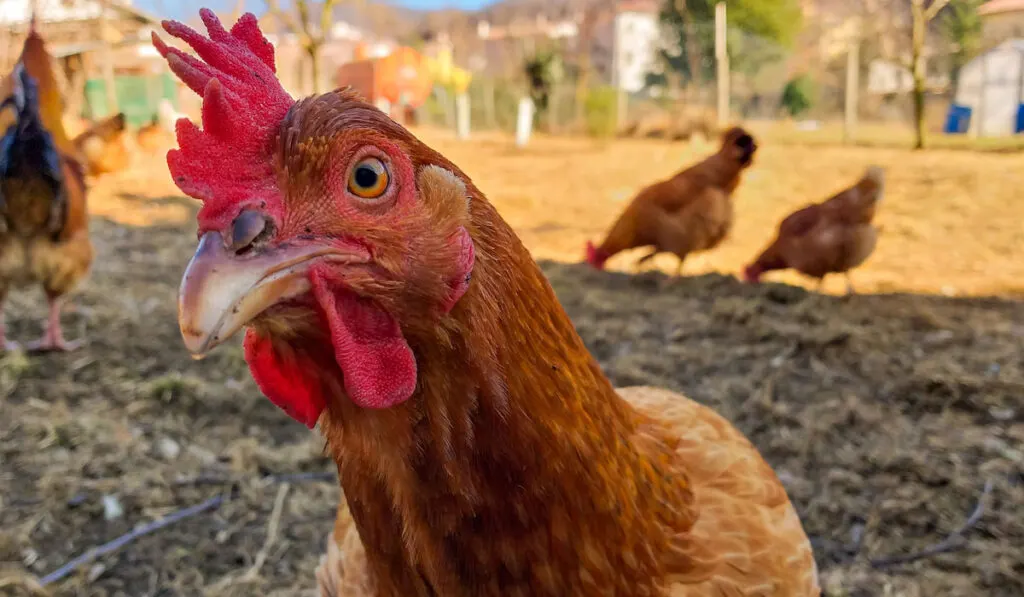
Hatching/Raising
The New Hampshire Red chicken is a sturdy and versatile breed. Here are the tenets of hatching and raising New Hampshire Red chicken.
Hatching
New Hampshire Red chicken eggs usually hatch after 21 days, and their young are robust and active.
They are perfect for incubation since they have reasonable hatch rates.
Brooding
The chicks mature fast and are simple to raise. They effectively convert feed into body mass thanks to their high feed conversion rate.
Ensure you keep the chicks warm and dry and provide access to food and water.
Feeding
For the first 6 to 8 weeks, feed your New Hampshire red chicks a beginning feed. After that, until they are fully grown, you provide them with grower feed.
Ensure you provide them with balanced and nourishing food to enhance their growth and development.
Housing
New Hampshire Red chicks will need a safe, roomy brooder with lots of space for movement and exploration.
You must transfer them to a more spacious coop or enclosure with access to the outdoors as they mature.
Noise Level
Like every breed of chicken, the New Hampshire Red chicken can make varying noises.
The roosters are the loudest birds. They crow to assert their supremacy and announce the beginning of a new day.
On the other hand, hens are often quieter. Though, they may cluck or croak, especially when laying eggs.
Regarding total noise level, New Hampshire Reds have moderate vocalizations. They are not as boisterous as other breeds, such as the Plymouth Rock or the Rhode Island Red.
Also, they are less quiet than the Sussex and the Orpington.
Remember that a chicken’s environment, social dynamics, and personality can impact its vocalization.
You can consider retaining a smaller flock if you’re worried about noise levels.
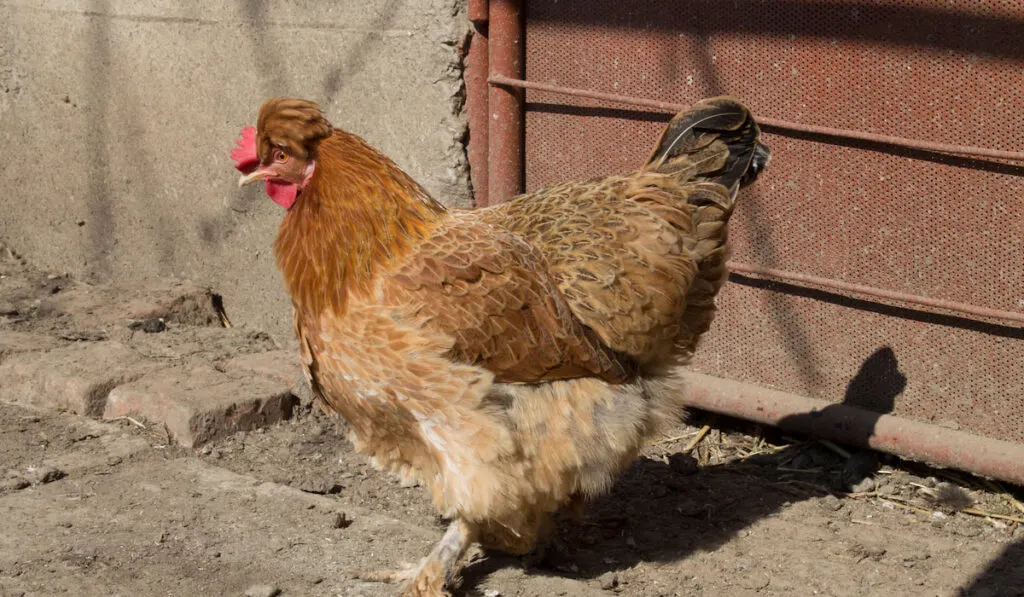
Common Health Issues
The New Hampshire Red breed is less vulnerable to diseases. However, they sometimes experience specific health issues. Some of the common health problems include:
Egg-Laying Problems
New Hampshire Reds are prone to egg-laying-related complications being heavy layers.
They may suffer from egg-laying exhaustion, egg peritonitis, and egg-laying tumors.
Respiratory Problems
Newcastle disease, egg-laying respiratory issues, and infections like mycoplasma can all affect the New Hampshire Reds. These problems threaten their overall health.
Foot Problems
New Hampshire Red chickens can experience foot issues. These include bumblefoot, footpad dermatitis, and other foot issues.
Parasites
The breed is susceptible to mites, lice, and worm infestation. These parasites affect their health.
Nutritional Deficiencies
New Hampshire Red chickens need a constantly balanced diet. A lack of vital vitamins and minerals in their diet can cause anemia, brittle bones, and a compromised immune system.

Pros and Cons
Rearing the New Hampshire Red breed has several pros and cons.
Pros
Good Layers
The New Hampshire Red is one of the top layers among chicken breeds.
Hardiness
The New Hampshire Red is a resilient bird that can tolerate extreme weather. They are also less susceptible to illnesses.
Good Meat Quality
Apart from being good layers, they are also a sound option for producing meat. New Hampshire Red chickens have an excellent meat-to-bone ratio.
Docile Nature
The New Hampshire Red is docile and friendly. This makes it an easy-to-train breed.
Cons
High Feed Consumption
This breed has a higher feed intake due to its rapid development and high egg output. Thus, the New Hampshire Red is more expensive to maintain.
Broodiness
The New Hampshire Red chicken is a broody breed. They have the propensity to become broody and stop laying eggs.
Aggression
Despite their peaceful nature, they can sometimes become aggressive, especially when they are broody.
Heat Sensitivity
While they can thrive in diverse conditions, the New Hampshire Red chicken is less heat-tolerant than other breeds. Therefore, hotter climates can negatively impact egg production.
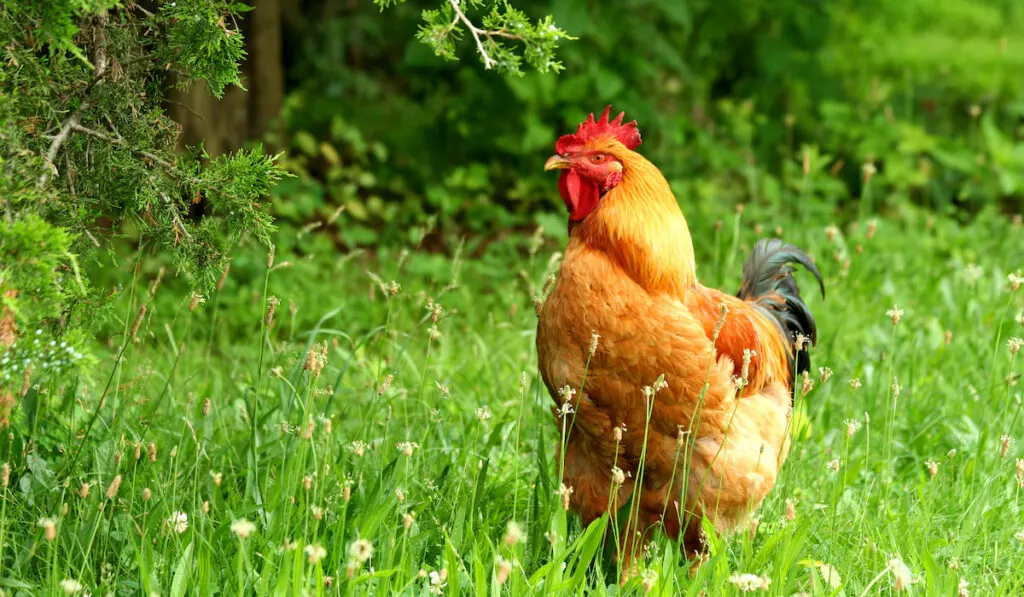
Similar Breeds
Several breeds have a similar appearance, disposition, and egg-laying prowess as the New Hampshire Red. They include:
Rhode Island Red
The Rhode Island Red is the New Hampshire Red’s closest relative. They are sturdy, superb, and lay brown eggs.
Plymouth Rock
This breed resembles the New Hampshire Red in appearance and disposition. The Plymouth Rocks are gentle and produce quality brown eggs.
Sussex
The Sussex chickens are hardy and reliable egg layers. They are an excellent choice for backyard flocks because of their friendly and energetic personalities.
You can find them in colors ranging from black to white.
Leghorn
The Leghorn is a popular Mediterranean breed with a gentle nature and propensity for egg production. They have slim bodies and lay white eggs.
Jersey Giant
The Jersey chicken is the largest breed, resembling the New Hampshire Red in physical appearance. They have an amiable nature and produce quality brown eggs.

Frequently Asked Questions (FAQs)
A New Hampshire Red chicken can live for 5 to 8 years. With proper care, some can live for over ten years.
The New Hampshire Red chicken can produce approximately 200 to 220 eggs annually.
The New Hampshire Red is a calm and resilient breed.
The New Hampshire Red chickens are medium-sized well-built birds with unique red feathers.
The New Hampshire Red chicken originated in New Hampshire in the United States in the early 20th century.
Final Thoughts
The New Hampshire Red breed is viable for small-scale homesteading or backyard chicken keeping. This dual-purpose bird is famous for its resilience and productivity.
With a favorable meat-to-bone ratio, they are also preferable for commercial production.
The New Hampshire Red is an excellent addition to your backyard coop, ensuring a quality meat and egg supply for your family.
Resources
I wrote this article from my experience raising chicken and the following sources:
- https://livestockconservancy.org/heritage-breeds/heritage-breeds-list/new-hampshire-chicken/
- https://extension.umn.edu/small-scale-poultry/raising-chickens-eggs
- http://afs.okstate.edu/breeds/poultry/chickens/newhampshirered/
- https://blogs.ifas.ufl.edu/brevardco/2018/02/12/666/
- https://poultry.extension.org/articles/poultry-management/sexing-day-old-chicks/
- https://www.canr.msu.edu/uploads/234/69325/Chicken_Breed_Chart_to_Help_Choose_Your_Chicken.pdf
- https://www.ncbi.nlm.nih.gov/pmc/articles/PMC8271170/
- https://extension.unh.edu/sites/default/files/migrated_unmanaged_files/Resource007786_Rep11398.pdf
- https://opensanctuary.org/common-chicken-health-issues/
- https://www.sciencedirect.com/science/article/pii/S0032579119324691
- https://www.humanesociety.org/sites/default/files/docs/hsus-report-breeding-egg-welfiss.pdf
- https://watchbird-ojs-tamu.tdl.org/watchbird/index.php/watchbird/article/view/2229
